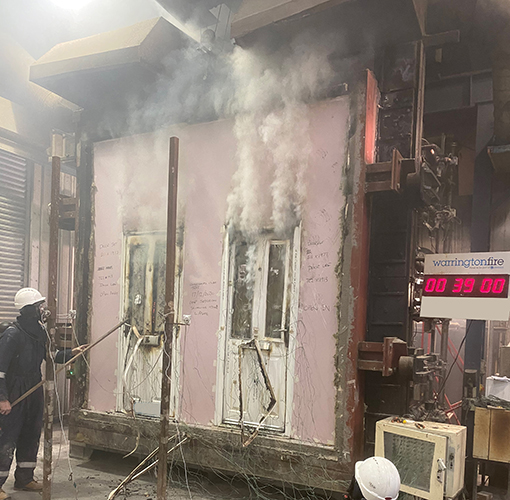Introduction to Composite Fire-Resistant Doorsets
Composite Fire-resistant Doorsets have been manufactured and supplied to the UK’s building industry for both new dwellings and refurbishment of existing homes since the 1990s although they became the door of choice for refurbishment of flats in the last 15 years. The primary use of composite fire-resistant doorsets is as flat entrance doors, these can be either an external or an internal doorset although many composite doorset manufacturers supply the same specification door for both locations.
The specification of Composite Doorsets is given in BS 8529:2017 – Composite doorsets. Domestic external doorsets – Specification.
Composite doorsets are defined in BS 8529:2017 as:
‘hinged or pivoted doorsets with composite based leaf or leaves, with or without glazing in the leaf, and/or a composite door frame’: and
A composite door leaf is defined as:
‘door leaf whose structure contains multiple materials, generally of sandwich construction, contributing to the structural performance of the product’
NOTE: Doorsets with either the door leaf or the door frame manufactured from a composite material are considered to be composite doorsets and are covered by this British Standard. Composite doorsets may be of single or double rebate construction.
Composite fire-resistant flat entrance doorsets have been proven to provide containment, protecting against the spread of fire and providing smoke control, enabling occupants to either remain in their flats or to escape safely and allow fire and rescue services to effectively fight fires.
Until recently, most composite doorsets were tested to BS 476-22 for fire-resistance and BS 476-31.1 for smoke control. Although both British and European test standards are accepted when demonstrating compliance to Building regulations in the UK, most composite fire-resistant doorset manufacturers are now using European test standards EN 1634-1 for fire-resistance and EN 1634-3 for smoke control. By testing and classifying to the EN standards manufacturers are able to comply to the Construction Products (Amendment etc) (EU exit) Regulations 2020 (CPR). The CPR only allows performance declarations, based on European tests (EN), to enable external fire-resistant doorsets to be UKCA marked. It must be noted that the UK version of the CPR only allows fire-resistant doorsets that comply with a Designated Standard (DS) to have a Declaration of Performance drawn up by the manufacturer and be UKCA marked.
Although the UK has left the EU, the use of CE marking in accordance with the CPR currently in use in Europe, using harmonised European Standards (hENs) that have been cited in the OJEU. This provision to allow CE marked fire-resistant doorsets ends on 31st December 2022.
Based on the above, only fire-resistant doorsets with a stated intended use as an external doorset are subject to the requirements of the CPR, internal doorsets are not subject to the CPR as the European Standard for internal doorsets had not been cited in the OJEU when the UK left the EU on 31st January 2021.
It should be noted that although the definition of a composite door relates to the door leaf and door frame, there are a number of other components that are critical to the fire-resistance of a composite doorset, as is the case with fire-resistant doorsets manufactured from other materials (wood, steel etc.). These components include insulating glass units (IGUs), intumescent materials, essential hardware such as hinges, locking systems, door closers, other hardware such as letterplates and viewers and weather-strips and thresholds
It is the combination of the door leaf, door frame and these other components that provides the fire-resistant properties of the doorset and variation in or substitution of any of these components may result in the fire-resistance performance of the doorset, when exposed to fire, being compromised. It is for this reason that it is essential for those responsible for approving fire doorsets carry out due diligence to ensure the doorset supplied is identical to the doorset that has been shown by testing, to provide the level of fire-resistance required or changes to the doorset specification are approved in an assessment or Field of Application produced by a suitably qualified organisation. Any variations or substitutions must be approved through a robust assessment process carried out by a suitably qualified body employing qualified and experienced assessors. These bodies should be accredited by United Kingdom Accreditation Service (UKAS) or similar body and follow the Guidance produced by the Passive Fire Protection Forum, ‘Guide to undertaking technical assessments of fire performance of construction products based on fire test evidence’.
Following the tragic event on 14th June 2017 at Grenfell Tower, the Metropolitan Police and the Ministry of Housing, Communities and Local Government (MHCLG) carried out a fire test program, based on BS 476-22:1987 – ‘Fire tests on building materials and structures. Method for determination of the fire resistance of non-loadbearing elements of construction’, of composite fire-resistant doorsets manufactured by various manufacturers in 2018.
The Building Regulation guidance contained in Approved Document B states ‘C3 The requirement is for test exposure from each side of the doorset separately. The exception is lift doors, which are tested from the landing side only’ and although MHCLG, now the Department for Levelling UP, Housing and Communities (DLUHC), that timber doorsets and metal doorsets, based on the contents of EN 1634-1, may in certain configurations, be tested from one side only, confirmed that composite doorsets must be tested with exposure to fire from both sides.
The MHCLG tests were carried out by exposing the doorsets to fire from both sides, this being the requirement shown in the Building Regulations guidance documents, AD B, volumes 1 and 2. Prior to this test program, based on the relevant clauses in BS 476-22, UKAS accredited test houses and certification bodies advised that composite doorsets only needed to be tested with the door opening in towards the furnace, as this had been identified by them as the most onerous direction. It should be noted that the tests carried out by MHCLG did not show failure of either the door leaves, door frames or glazing units but some premature failures occurred in the retention of glazing in the door leaf and failures of other components such as letterplates. Where early failure of components such as letterplates occurred, testing continued and doorsets continued to provide fire-resistance in excess of 30 minutes.
Since 2018 extensive performance testing of Composite Fire-resisting Doorsets by manufacturers and component manufacturers to both British and European Standards, exposing the doorset to fire from both sides, has consistently demonstrated that composite doorsets provide fire protection of similar levels expected from other non-composite fire-resisting doorsets.
In January 2020, the Secretary of State briefed the House of Commons on a number of issues, including fire-resistant doorsets, and following his briefing MHCLG published two guidance documents. These may be downloaded from:
Consolidated Advice Note – replaces advise notes 1 – 21
‘Advice for Building Owners of Multi-storey, Multi-occupied Residential Buildings’
Fire-resistant doorsets – new build, replacement and existing
‘Annex A – Advice for building owners on assurance and assessment of flat entrance fire doors’
Further information providing the ACDM interpretation of requirements can be viewed as follows:
Review process following publication of MHCLG Advice note
Building Regulation Requirements
Testing and classification of Composite Fire Doors
Certification
Legacy Composite fire doors – pre-2018
To become a member of the Association of Composite Door Manufacturers, manufacturers must be or in the process of becoming a certified manufacturer through a UKAS accredited Independent third-party certification body and therefore specifiers can be assured of the performance of Composite Fire Doors sourced from ACDM members.

